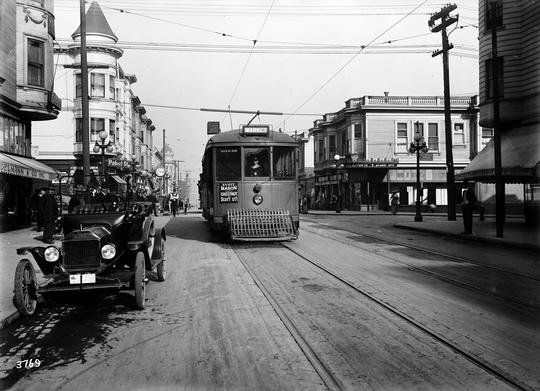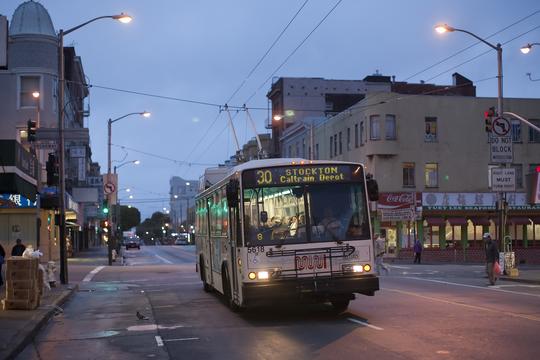It’s always fun to deal with young reporters. Whenever I talk with one, it reminds me of that old George Michael lyric: “I know all the games you play, because I played them too.”

F-Stockton streetcar, southbound on Stockton at Vallejo, 1916. Muni Archives photo, displayed in our San Francisco Railway Museum’s Muni Centennial exhibition.
Current case in point: a quite readable piece by the Bay Citizen that I was told was to be about Muni’s centennial. A shorter version runs in the Bay Area edition of Sunday’s New York Times.
After ten years as a reporter myself, and many more than that working with reporters, I’ve been through this news story game enough times — from both sides — to know that the stated reason for a story is often not the real one. In this case, it was clear within a couple of minutes what the reporter’s real agenda was: tell everyone that despite all the ways things have gotten faster in the world, major Muni lines have gotten slower.
Whether that would be a true apples-to-apples comparison didn’t matter.

A 30-line bus (the 30 replaced the F-Stockton in 1951) southbound on Stockton at Broadway, one block from the earlier photo. Note, though, that while the 1916 picture is in the middle of the day (no doubt a weekday since it was taken by a Muni employee), this picture is taken in the evening. Anybody who has been on Stockton during business hours knows the buses crawl through the crowds today. Heck, if traffic on Stockton were always like this, we could save that $1.6 billion on the Central Subway! Bay Citizen photo.
I spent a lot of time explaining to him how much smaller the city population was in 1920; how few automobiles were on the road (and virtually no bicycles); and several other factors. Apparently, from the quotes, so did other folks who know the context. I knew, of course, that nothing was going to change the trajectory of the story, because it’s just too titillating to be able to say that the trip downtown from the Avenues or the Marina is slower now than it was then.
The reality that many of the Avenues weren’t even paved back then, because there were no houses there that needed streets, or that the Marina in 1920 was yet to be built following the clearing of the 1915 World’s Fair are just messy facts that get in the way of a good story…as is the reality that the stretch of Stockton Street pictured in this post was a relatively low-density community then, while today it’s part of one of the highest-density communities in America (though the street hasn’t gotten any wider).
Don’t mean to sound too harsh here. The reporter did do a lot of fact checking and called numerous sources; it was in no way a sloppy job. The schedule times cited are quite accurate. And it’s an entertaining read, with great then-and-now pictures on the Bay Citizen site. It’s just amusing to see, over and over, reporters back into these stories instead of just saying what their premise is.
On balance, I think it’s really too bad that the Bay Citizen’s coverage of topics like this is slated to go away very soon as part of their merger with the Center for Investigative Reporting. Whether they forced the premise or not, we love it that they took the time to look back at Muni’s history. Perhaps at least some readers will infer what we told the reporter directly: Muni service helped build major parts of San Francisco, including the Sunset, Parkside, and Marina Districts. And that’s something to celebrate this centennial year.